
Updated September 3, 2022
This is the thirty-seventh in a series that introduces and describes the various dive services and sites for worldwide liveaboard dive safaris. This one focuses on Cuba liveaboards.
In addition to this one on liveaboards, the best worldwide scuba diving destinations are reviewed in their own series. To check them out, or other liveaboards, click on Liveaboards/Resorts on the menu at the top and choose a title from the list.
Have you ever been diving in Cuba before? If so, I’d love to know about your experience. What dive shop or liveaboard did you use? Which dive spots are the best and what are the conditions there regarding the visibility, current, water temperature, sealife attractions, etc.? Please post your response in the comments section at the bottom and we’ll all learn something we can use.
Jardines de la Reina Diving Liveaboard
Background
In the 1950s under the Batista regime, Cuba was becoming a major tourist destination, a sort of Las Vegas of the Caribbean. From the relative, if lopsided, prosperity of that era, the Communist takeover, nationalization of the US oil companies, subsequent US embargo, and Cuban embrace of the Soviets ushered in a period of isolation that saw tourism evaporate.
In the 1990s the authorities decided to loosen restrictions and started to encourage visitors again with many enthused to go for a look. Until the last few years, this renewed tourism was fueled mostly by Canadians and Europeans. Today the hoops for Americans to jump through have been greatly reduced, and in fact the liveaboards I introduce here have the necessary authorizations organized for Americans to easily travel to Cuba.
The approximately 3 million tourists per year currently are a significant economic driver and incentive for further internationalization.

Undersea World
The site of the liveaboards and top diving location in Cuba is Jardines de la Reina (Gardens of the Queen). Located 80 kilometers (50 miles) south of the main island of Cuba and 128 kilometers (80 miles) northeast of Cayman Brac, it has a mangrove and coral system that is 240 kilometers (150 miles) long which serves as a barrier reef and nursery for large schools of baitfish.
The majority of the central section is a protected national marine park where fishing and inhabitation are prohibited.
There is an interesting subsea terrain with steep slopes and caverns with a rich Caribbean reef of corals, fans, and various tube, barrel, and organ pipe sponges.
It is home to lots of macro critters like lobster and green moray eels, with schools of blue-striped grunts and yellowtail snappers. Humongous 90-180 kilogram (200-400 pound) jewfish, and big Nassau and black groupers can only be outdone by 7 species of shark including silky, Caribbean reef, blacktip reef, lemon, bull, nurse, hammerhead, and whale sharks. Sea turtles, tarpon, stingrays, and saltwater crocs are all commonly sighted and there are remnants of Spanish galleons to explore, as well.
Seasons and Conditions
Diving is good all year with the dry season from November through April, the best time for visibility and sea conditions.
The hurricane season is from May through October. Off the southern coast where Jardines de la Reina is situated, the effects of storms are less than on the opposite side with a smoother sea and better visibility, which can often be as good as 40 meters (130 feet).
Current is generally mild to non-existent.
Water temperature runs from 26-29°C (79-84°F) which means most divers won’t need more than a 3 mm wetsuit.
There are sites suitable for all levels of diver from open water to advanced levels.
Other Cuban and Regional Diving
There is interesting diving all around Cuba. Here’s my review of other popular Cuban dive sites:
For reviews of eastern Florida and other Caribbean dive locations and liveaboards, check out these articles:
- Scuba Diving in Islamorada Florida
- Scuba Diving on Key West Florida
- Best Scuba Diving Key Largo Florida
- Scuba Diving West Palm Beach Florida
- Ft. Lauderdale Scuba Diving
- Scuba Diving St. Barts
- Scuba Diving St. Eustatius
- Scuba Diving in Saba
- Scuba Diving St Kitts and Nevis
- Best Scuba Diving St. Martin
- Scuba Diving Ambergris Caye Belize
- Best Guadeloupe Scuba Diving
- Anguilla Scuba Diving
- Scuba Diving in Antigua and Barbuda
- Best Scuba Diving Jamaica
- Best Dive Sites Cuba
- Scuba Diving the Dominican Republic
- Best Scuba Diving Panama
- Banco Chinchorro Diving Mexico
- Scuba Diving Playa Del Carmen
- Scuba Diving Tulum Mexico
- Cozumel Scuba Diving Review
- Scuba Diving Cancun Mexico
- Best Scuba Diving Puerto Rico
- Scuba Diving St Vincent and the Grenadines Review
- St. Lucia Scuba Diving Review
- Turks and Caicos Scuba Diving Review
- Best US Virgin Islands Vacations Scuba Diving
- Best Trinidad and Tobago Vacations Scuba Diving
- Best Caribbean Beach Vacations Curacao Scuba Diving
- Best Caribbean Diving Destinations Aruba
- Best Caribbean Dive Vacations Bonaire
- Best Tropical Island Vacations Dominica Scuba Diving
- Best Caribbean Scuba Diving Los Roques Venezuela
- Barbados Scuba Dive Vacations
- Grenada Scuba Diving Review
- Best Scuba Diving Caribbean – Martinique
- Best British Virgin Island Diving Liveaboard
- Best Bahamas Liveaboard Scuba Vacations
- Best Belize Dive Trips & Cocos Island Diving
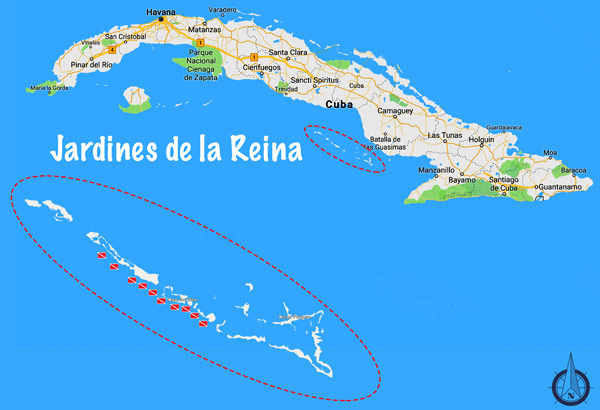
Selected Jardines de la Reina Dive Sites
- Cabezo de la Cubera (Snapper’s Head): 6-18 meters (18-60 feet), large circular coral formation with many species of snapper, big Goliath and other groupers, Caribbean reef sharks, roughtail stingrays, green moray eels, turtles, schools of blue tangs, and tarpon, from the formation is a wall running from 7-18 meters (22-60 feet) with a sandy bottom at the base, all levels
- Black Coral I and II: two sites with coral reefs dropping off from their plateau at 18-21 meters (60-70 feet) to around 30 meters (100 feet), lots of Caribbean reef sharks, up to 20 at a time, forests of black coral, big sponges, and gorgonians, schools of midnight parrotfish and jacks, black groupers, king mackerel, moray eels, nurse sharks, hawksbill turtles, experienced level
- Pipin: wall from 15-30 meters (50-100 feet), big schools of grunts, jacks, and tarpon up to 50 at a time, silky sharks up to 12 in a group, hammerheads possible, turtles, eagle rays, Caribbean reef sharks deeper, forests of black coral, experienced level
- Vicente: 40 meters (130 feet) maximum depth, a wall going to the maximum depth, next to the wall are pinnacles rising to 21 meters (70 feet), covered in a variety of sponges, gorgonians, corals, green morays, nudibranchs, butterflyfish, queen angelfish, big groupers, silky and Caribbean reef sharks, black coral forests in the deeper areas, hammerheads, wahoo, yellow and horse-eye jacks along the wall, experienced level
- Farallón: coral mountain topping at 15 meters (50 feet), sandy bottom at 30 meters (100 feet), and a series of tunnels, lots of pelagics, schools of grunts, silver tarpons, and jacks, turtles, rays, Caribbean reef, and silky sharks, experienced level
- Five Seas: 7-20 meters (22-68 feet), a wall with several overhangs, black coral, sponges, resident schools of tarpon and 15 Caribbean reef sharks, black groupers, snappers, the wreck of a 15-meter (50-foot) pilot boat named Five Seas, scuttled to become an artificial reef, well encrusted with sponges and coral, black coral, schools of jacks, and green moral eels within or nearby, all levels
- El Galeon: 17 meters (55 feet), two wrecks, an old galleon, and a nearby fishing boat, well encrusted with large brain corals, macro critters including crabs and lobster, small coral gardens with a variety of corals, sponges, and tubeworms in the sand nearby with queen angelfish, yellowhead wrasses, stoplight parrotfish, excellent night dive, all levels
- Octopus Cave: 5-16 meters (15-54 feet), a wall with a cave at 6 meters (18 feet) that extends into the wall 70 meters (230 feet), but penetration is restricted, iridescent sponges with decorator crabs, blind brotulas seen only at night in the mouth of the cave, sponges and gorgonians cover the wall, schools of snapper, grunts, mullet, and porgies around pillar corals at the edge of the wall, schools of tarpon, Goliath groupers, Caribbean reef sharks, all levels
- Anclitas: 17 meters (55 feet), canyons and tunnels with lots of corals and sponges, Christmas tree worms, drums, fairy basslets, redband parrotfish, yellow line arrow crabs, lionfish, hogfish, porgies, tiger groupers, hawksbill turtles, all levels
Jardines de la Reina Liveaboard Dive Boats
The Avalon I and Avalon II are very similar full-service liveaboard diving yachts. The Tortuga is a floating hotel based right on the Jardines de la Reina that uses speed boats for diving.
Three new liveaboard yachts have recently started offering services to Jardines de la Reina. You can check out the details at these links:
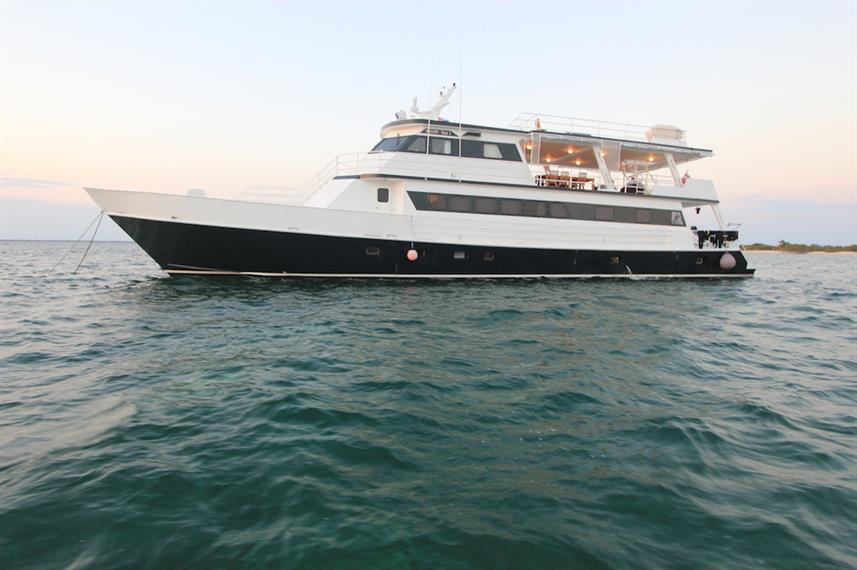
Featuring
- No current schedule for 2022 and 2023, possible availability by charter
- 8 day/7 night cruises around Jardines de la Reina, approximately 18 dives total
- Itinerary: Anclitas, Pipin, Mariflores, Boca de Piedras, Farallon, La Cabeza del Coral Negro, Tunel Azul, El Hueco del Pulpo, La Cueva de Carmen, Las Cruces, Vicente, Puente Escondido.
- Daily housekeeping, laundry service, aircon cabins, warm water showers, TV in cabins, en-suite bathrooms
- Air-conditioned saloon, audio & video entertainment
- Outdoor dining, western, local, and vegetarian food, sun deck
- The crew speaks English and Spanish
- Shaded diving deck
- Non-diver (snorkeler) friendly
- Separate rinse for u/w camera
- Inquire about the availability of Nitrox
- 2 x 150 HP Yamaha motorized dinghies
Check it out on Liveaboard.com
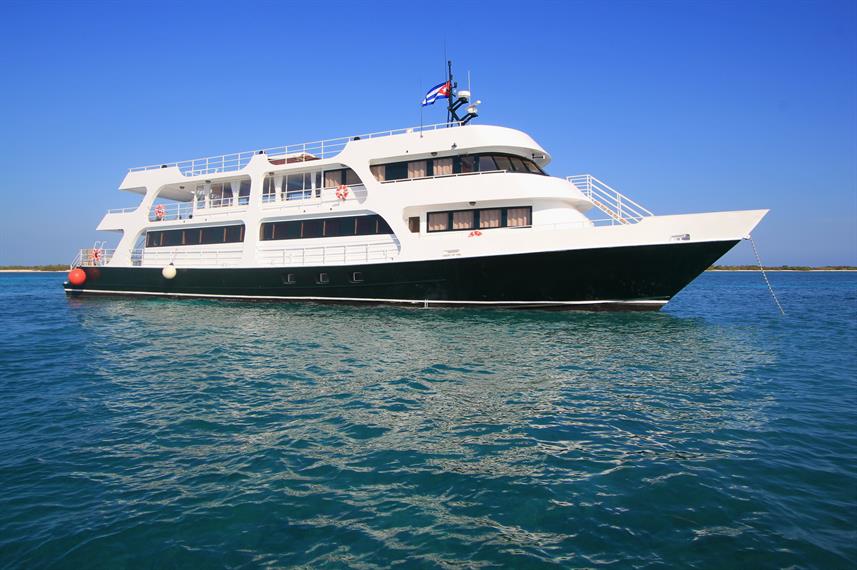
Featuring
- Currently available by charter only
- 8 day/7 night cruises around Jardines de la Reina, approximately 18 dives total
- Itinerary: Anclitas, Pipin, Mariflores, Boca de Piedras, Farallon, La Cabeza del Coral Negro, Tunel Azul, El Hueco del Pulpo, La Cueva de Carmen, Las Cruces, Vicente, Puente Escondido.
- Daily housekeeping, laundry service, aircon cabins, warm water showers, TV in cabins, en-suite bathrooms
- Air-conditioned saloon, audio & video entertainment
- Outdoor dining, western, local, and vegetarian food, sun deck
- The crew speaks English and Spanish
- Shaded diving deck
- Non-diver (snorkeler) friendly
- Separate rinse for u/w camera
- Nitrox available
- 2 x 150 HP Yamaha motorized dinghies
Check it out on Liveaboard.com
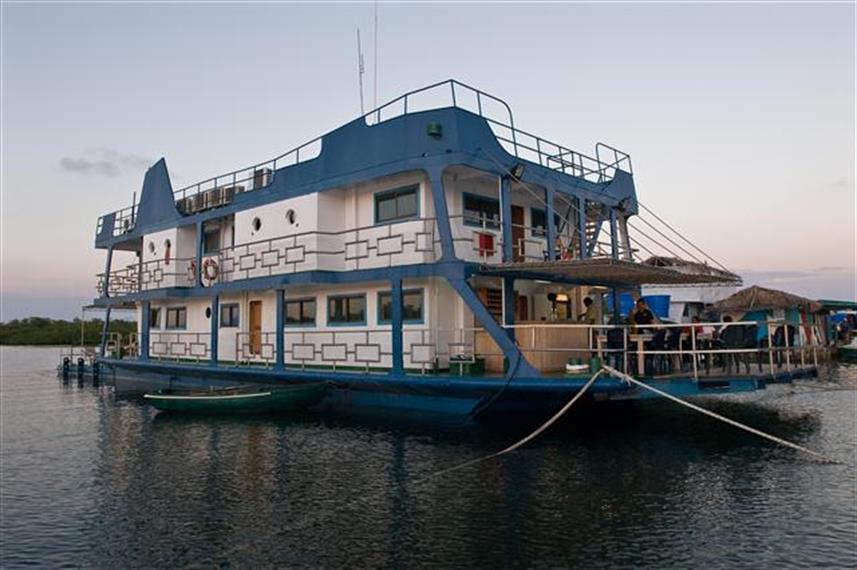
Featuring
- No current schedule for 2022 and 2023, check back for any change
- 8 day/7 night cruises around Jardines de la Reina, approximately 18 dives total
- Itinerary: Anclitas, Pipin, Mariflores, Boca de Piedras, Farallon, La Cabeza del Coral Negro, Tunel Azul, El Hueco del Pulpo, La Cueva de Carmen, Las Cruces, Vicente, Puente Escondido.
- Daily housekeeping, laundry service, aircon cabins, warm water showers, TV in cabins, en-suite bathrooms
- Air-conditioned saloon, audio & video entertainment
- Free internet
- Outdoor dining, western, local, and vegetarian food, sun deck, leisure deck
- The crew speaks English and Spanish
- Shaded diving deck
- Non-diver (snorkeler) friendly
- Photography station, separate rinse for u/w camera
- Inquire about the availability of Nitrox
- 2 x 150 HP Yamaha motorized dinghies, 1 additional tender
Check it out on Liveaboard.com
Jardines de la Reina Liveaboard Dive Boat Comparison Table
| MV Avalon I | MV Avalon II | Tortuga | |
|---|---|---|---|
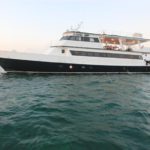 |  | 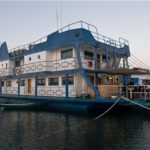 |
|
| Length | 37 m | 40 m | 34 m |
| Guests | 18 | 20 | 25 |
| Crew | 11 | 9 | 10-12 |
| Equipment | $200/week | $200/week | $200/week |
| Snorkel Friendly | Yes | Yes | Yes |
| Nitrox | To Be Arranged | $100/trip | To Be Arranged |
| Single R. | +65% | NA | +65% |
| Price/Day | $298 | Charter Rates | $418 |
Cuba Hotels and Transportation
Jose Marti International Airport in Havana is the port of entry that handles flights from Canada, Mexico, Europe, Beijing, and several US cities including Charlotte, Newark, and Miami. From there you will need to make your way to Port Jucaro. There are several ways to do it. You should get the latest advice from the liveaboard operator for the most convenient and effective way to do it as well as their recommendations for hotel accommodation if needed.
Cuba Photos
With the pristine coral reef, variety of sharks, rays, grouper, reef fish, wrecks, other underwater attractions, and scenic and historic shoreside targets, there are many excellent photo opportunities. For information and reviews of dive cameras, click here:
Scuba Diving Trip Insurance
A cushion for emergencies provides peace of mind when on vacation. I recommend this diving insurance as they have worldwide coverage and provide scuba divers a quality insurance and medical assistance service.
Feedback and Comments
I hope you found this post on Cuba scuba diving interesting and useful. If you have any questions or ideas, please feel free to share them in the comments section. I’d love to know of any experience you have diving there. If there is no comments section directly below, click here: >>comments<<